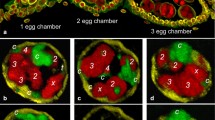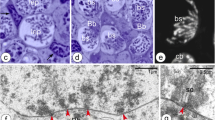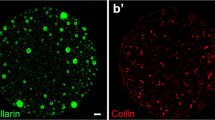Abstract
Origin and function of the nucleolar apparatus in nurse cell nuclei of Calliphora erythrocephala have been investigated by cytological and autoradiographic methods in some inbred lines of laboratory blowflies with well paired polytene chromosomes in the nurse cell nuclei. Besides the nucleolus at chromosome VI large numbers of multiple free nucleoli develop in the highly polyploidized nurse cells during oocyte growth. The nucleoli incorporate H3-uridine in a considerable amount producing a homogeneous and RNase-sensitive label even after short time incubation. Their capacity of RNA synthesis is independent of their spatial relationships to other nuclear components. DNA particles in the nucleoli could be identified by the Feulgen reaction and by fluorescence staining with N,N'-diethylpseudoisocya-ninchloride, which also demonstrates the existence of own templates for autonomous RNA synthesis. There are indications that the nucleolus' own DNA is produced by gene amplification beyond the level of endomitotic polyploidization in the nurse cell nuclei. A quantitative estimation of grain density in the autoradiograms shows a rigorous shift of rRNA synthesis: at least 72% of all newly synthesized macromolecular RNA in nurse cell nuclei as contrasted to 13 % of nucleolar RNA synthesis in bristle forming cells with a similar degree of polyploidy. It seems that the nurse cell nuclei of Calliphora in addition to polyploidization increase their template capacity for synthesizing rRNA in a similar way as has repeatedly been demonstrated for Amphibia. Cytological and physiological peculiarities of the nurse cells have been discussed from the viewpoint of their functional similarity to the oocyte nucleus.
Similar content being viewed by others
References
Bauer, H.: Die wachsenden Oocytenkerne einiger Insekten in ihrem Verhalten zur Nuklealfärbung. Z. Zellforsch. 18, 254–298 (1933).
Beermann, W.: Riesenchromosomen. Protoplasmatologia. VI/D. Wien: Springer 1962.
Bier, K.: Endomitose und Polytänie in den Nährzellkernen von Calliphora erythrocephala. Chromosoma (Berl.) 8, 493–522 (1957).
— Quantitative Untersuchungen über die Variabilität der Nährzellkernstruktur und ihre Beeinflussung durch die Temperatur. Chromosoma (Berl.) 10, 619–653 (1959).
Bier, K.: Der Karyotyp von Calliphora erythrocephala Meigen unter besonderer Berücksichtigung der Nährzellkernchromosomen im gebündelten und gepaarten Zustand. Chromosoma (Berl.) 11, 335–364 (1960).
— Unterschiedliche Reproduktionsraten im Eu- und Heterochromatin: ein Weg zur Kerndifferenzierung? Verh. Dtsch. Zool. Ges. 1961. Zool. Anz., Suppl. 25, 102–110 (1962).
— Autoradiographische Untersuchungen über die Leistungen des Follikelepithels und der Nährzellen bei der Dotterbildung und Eiweißsynthese im Fliegenovar. Wilhelm Roux' Arch. Entwickl.-Mech. Org. 154, 552–575 (1963).
— Zur Funktion der Nährzellen im meroistischen Insektenovar unter besonderer Berücksichtigung der Oogenese adephager Coleopteren. Zool. Jb., Abt. allg. Zool. u. Physiol. 71, 371–384 (1965).
— W. Kunz u. D. Ribbert: Struktur und Funktion der Oocytenchromosomen und Nukleolen sowie der Extra-DNS während der Oogenese panoistischer und meroistischer Insekten. Chromosoma (Berl.) 23, 214–254 (1967).
— Insect oogenesis with and without lampbrush chromosomes. Chromosomes Today 2, 107–115 (1969).
-, u. W. Müller: DNS-Messungen bei Insekten und eine Hypothese über retardierte Evolution und besonderen DNS-Reichtum im Tierreich. Biol. Zbl., (in the press, 1969).
Breuer, M. E., and C. Pavan: Behavior of polytene chromosomes of Rhynchosciara angelae at different stages of larval development. Chromosoma (Berl.) 7, 371–386 (1955).
Brown, D. D., and I. Dawid: Specific gene amplification in oocytes. Science 160, 272–280 (1968).
Callan, H.G.: Chromosomes and nucleoli of the axolotl, Ambystoma mexicanum. J. Cell Sci. l, 85–108 (1966).
Chandley, A. C.: Studies on oogenesis in Drosophila melanogaster with H3-thymidine label. Exp. Cell Res. 44, 201–215 (1966).
Crouse, H. V., and H.-G. Keyl: Extra replications in the “DNA-Puffs” of Sciara coprophila. Chromosoma (Berl.) 25, 357–364 (1968).
Davidson, E. H.: Genomic function in amphibian oogenesis. Accad. naz. Lincei 104, 77–99 (1968).
Ebstein, B.: Tritiated actinomycin D as a cytochemical label for small amounts of DNA. J. Cell Biol. 35, 709–713 (1967).
Gall, J.: Differential synthesis of the genes for ribosomal RNA during amphibian oogenesis. Proc. nat. Acad. Sci. (Wash.) 60, 553–560 (1968).
-The genes for ribosomal RNA during oogenesis. Genetics (in press, 1969).
— H. Macgregor, and M. Kidston: Gene amplification in the oocytes of dytiscid water beetles. Chromosoma (Berl.) 26, 169–187 (1969).
Heinonen, L., and O. Halkka: Early stages of oogenesis and metabolic DNA in the oocytes of the house cricket, Acheta domesticus (L). Ann. Med. exp. Fenn. 45, 101–109 (1967).
Keyl, H., u. K. Hägele: Heterochromatin-Proliferation an den Speicheldrüsen-chromosomen von Chironomus melanotus. Chromosoma (Berl.) 19, 223–230 (1966).
Kezer, J.: Cit. in: W. J. Peacock: Chromosome replication. Nat. Cancer Inst. Monogr. 18, 101–131 (1965).
Kunz, W.: Funktionsstrukturen im Oocytenkern von Locusta migratoria. Chromosoma (Berl.) 20, 332–370 (1967).
— Lampenbürstenchromosomen und multiple Nukleolen bei Orthopteren. Chromosoma (Berl.) 21, 446–462 (1967).
Kunz, W.: Die Entstehung multipler Oooytennukleolen aus akzessorischen DNS-Körpern bei Gryllus domesticus. Chromosoma (Berl.) 26, 41–75 (1969).
Lima-de-Faria, A., and M. J. Moses: Ultrastructure and cytochemistry of metabolic DNA in Tipula. J. Gell Biol. 30, 177–192 (1966).
— A. B. Nilsson, D. Cave, A. Puga, and H. Jaworska: Tritium labeling and cytochemistry of extra DNA in Achaeta. Chromosoma (Berl.) 25, 1–20 (1968).
Maurer, W., u. E. Primbsch: Größe der β-Selbstabsorption bei der H3-Autoradiographie. Exp. Cell Res. 33, 8–18 (1964).
Mechelke, F.: Reversible Strukturmodifikationen der Speicheldrüsenchromosomen von Acricotopus lucidus. Chromosoma (Berl.) 5, 511–543 (1953).
Meyer, G. F.: Interzellulare Brücken (Fusome) im Hoden und im Ei-Nährzellverband von Drosophila melanogaster. Z. Zellforsch. 54, 238–251 (1961).
Miller, O. L.: Extrachromosomal nucleolar DNA in amphibian oocytes. J. Cell Biol. 23, 60 A (1964).
Nash, D., and W. Plaut: On the presence of DNA in larval salivary gland nucleoli in Drosophila melanogaster. J. Cell Biol. 27, 682–686 (1965).
Pelling, C.: Ribonukleinsäuresynthese der Riesenchromosomen. Autoradiographische Untersuchungen an Chironomus tentans Fabr. Chromosoma (Berl.) 15, 71–122 (1964).
Perkowska, E., H. C. Macgregor, and M. L. Birnstiel: Gene amplification in the oocyte nucleus of mutant and wildtype Xenopus laevis. Nature (Lond.) 217, 649–650 (1968).
Ribbert, D.: Die Polytänchromosomen der Borstenbildungszellen von Calliphora erythrocephala unter besonderer Berücksichtigung der geschlechtsgebundenen Heterozygotie und des Puffmusters während der Metamorphose. Chromosoma (Berl.) 21, 296–344 (1967).
Rudkin, G. T., and S. L. Corlette: Disproportionate synthesis of DNA in a polytene chromosome region. Proc. nat. Acad. Sci. (Wash.) 43, 964–968 (1957).
Schäffner, H.: Untersuchungen an Oocytenkernen von Amphibien und Teleosteern mit Pseudoisocyanin. Histochemie 13, 346–378 (1968).
Schultz, J.: The relation of heterochromatic chromosome regions to the nucleic acids of the cell. Cold. Spr. Harb. Symp. quant. Biol. 21, 307–328 (1956).
Urbani, E., e S. Russo-Caia: Osservazioni citochimiche e autoradiografiche sul metabolismo degli acidi nucleici nella oogenesi di Dytiscus marginalis L. Rendic. Inst. Sci. Univ. Camerino 5, 19–50 (1964).
Author information
Authors and Affiliations
Rights and permissions
About this article
Cite this article
Ribbert, D., Bier, K. Multiple nucleoli and enhanced nucleolar activity in the nurse cells of the insect ovary. Chromosoma 27, 178–197 (1969). https://doi.org/10.1007/BF00326143
Received:
Accepted:
Issue Date:
DOI: https://doi.org/10.1007/BF00326143




